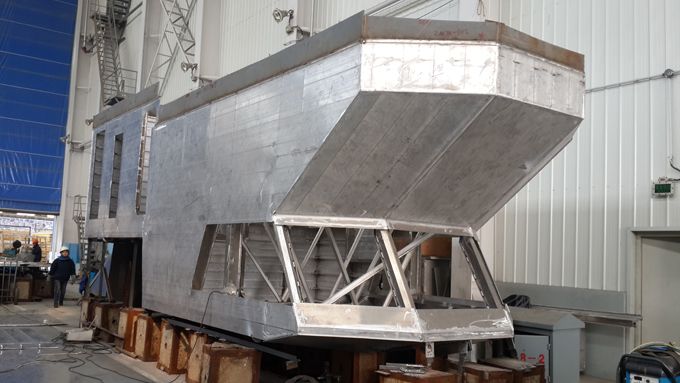Marine Grade Aluminum For Shipbuilding
Marine grade aluminum for shipbuilding is a type of high-performance aluminum alloy material designed for marine environment. It has the characteristics of light weight, corrosion resistance, high strength, etc., and is widely used in shipbuilding and marine engineering.

1. Material characteristics and classification
Marine-grade aluminum is mainly composed of 5000 series (Al-Mg), 6000 series (Al-Mg-Si) and 7000 series (Al-Zn-Mg) alloys. Among them:
- 5000 series alloys (such as 5052, 5083, 5086) have excellent seawater corrosion resistance due to their high magnesium content (usually 5%-6.5%), and are the preferred materials for hull structures, decks, and LNG tanks. For example, marine grade aluminum 5083 alloy can maintain high strength at low temperatures of -163℃, meeting the stringent requirements of liquefied natural gas transportation.
- 6000 series alloys (such as 6061, 6063, 6082) have excellent processing performance and are often used in ship doors and windows, furniture and deck accessories. In the construction of the aircraft carrier, marine grade aluminum 6063 alloy was used frequently.
- 7000 series alloys (such as 7A33) improve corrosion resistance by adding elements such as Sc and Zr, and their hardness is close to that of 2000 series cemented carbide, which is suitable for deep-sea submersibles and amphibious aircraft.
2. Key technologies and processes
- Welding technology: Friction stir welding (FSW) is the current mainstream process, which can achieve wireless welding, and the weld strength is close to that of the parent material. Haomei Aluminum can already produce 25 meter long FSW panel used for ship sidings.
- New aluminum alloys (such as 5xxx series containing Sc and Zr) increase the recrystallization temperature to make the strength retention rate after welding exceed 80%.
- Surface protection: Micro-arc oxidation (MAO) technology can form a ceramic coating on the surface of marine grade aluminum alloys, significantly improving wear resistance and corrosion resistance. Combined with cathodic protection (such as magnesium-rich coating) and environmentally friendly corrosion inhibitors (such as rare earth compounds), a multi-protection system is formed.
3. Application areas
(1). Shipbuilding:
- Hull structure: 5083 and 5086 aluminum alloys are used for the shell, which reduces weight while resisting seawater corrosion.
- Superstructure: 5052 and 5454 aluminum alloys are used to make decks and outfitting panels, and 6000 series marine grade aluminum alloys are used for doors, windows and furniture.
- Military field: 5000 series aluminum alloys are used for frigates and speedboats, and 7A33 is used for seaplanes and amphibious equipment.
(2). Marine engineering:
- LNG storage tanks: 5083 aluminum alloy maintains high strength and corrosion resistance at low temperatures and is the core material for combustible ice and natural gas storage devices.
- Marine platforms: 5754 aluminum alloy is used for floating docks to reduce corrosion in the splash zone; the apron material is switched from steel to aluminum to reduce maintenance costs and improve impact resistance.
4. Advantages and Challenges
(1). Advantages:
- Lightweight: The density is about 1/3 of that of steel, which can reduce the weight of the ship, increase the speed and reduce energy consumption. For example, after the Arksen85 research vessel uses aluminum, the weight of the entire ship is reduced by 30%-50%, and it can be recycled.
- Corrosion resistance: The oxide film formed naturally on the surface can resist seawater erosion. Some aluminum alloys (such as 5083) have a service life of more than 30 years in the splash zone.
- Environmental protection: 100% recyclable. Hydro and other companies have achieved low-carbon aluminum production, helping the sustainable development of the shipbuilding industry.
(2). Challenges:
- Welding strength: The weld strength after traditional welding is only 70% of the parent material, which needs to be improved by new aluminum alloys (such as 5000 series containing Sc-Zr) and FSW processes.
- Cost: The initial material cost is high and the processing technology requirements are strict. At present, the proportion of aluminum used in ships worldwide is still less than 5%.
5. Industry trends and standards
- Technological innovation: The research and development of high-magnesium 5000 series aluminum alloys (such as marine grade aluminum 5059) and high-strength 7xxx series aluminum alloys (such as 7A33) continues to advance, with the goal of improving strength while maintaining corrosion resistance.
- Market growth: With the development of the marine economy, the aluminum market for offshore equipment is expected to expand rapidly from 2024 to 2034, and 5000 series marine grade aluminum alloys will become mainstream due to their corrosion resistance advantages.
- International standards: ASTM B928 (American standard) and EN 13195-1 (European standard) specify the mechanical properties and corrosion resistance requirements of marine-grade aluminum to ensure the reliability of materials in harsh environments.
Marine grade aluminum, with its comprehensive performance advantages, is gradually becoming the core material in the field of shipbuilding and marine engineering, driving the industry towards lightweight, efficient and green development.








